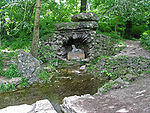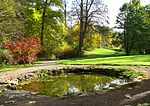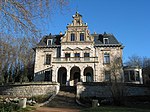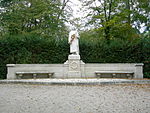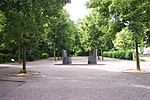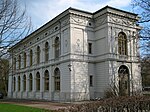Park on the Ilm

The Park an der Ilm (“Ilmpark” for short) is the largest and most famous landscape park in Weimar ( Thuringia ). It has hardly been changed since it was built in the 18th century with the participation of Johann Wolfgang von Goethe, making it one of the best-preserved parks of Classicism and Romanticism . Its visual axes , the bridges over the Ilm arches, the diverse park architecture and the valuable tree population, some of which come from overseas, are characteristic. The Ilm Park is part of the ensemble " Classical Weimar ", which by the 1998 UNESCO in the World Heritage List was added.
location
The park on the Ilm has an area of 48 hectares and extends on both sides of the Ilm over a length of 1.6 km and a width of approx. 300 m from the Weimar City Palace in the north to the Weimar district of Oberweimar in the south. The park is part of a kilometer-long green corridor that extends up the ilm to the foot of the Belvedere Palace Park and down the ilm to the Tiefurt Palace Park . The actual park on the Ilm is divided into the so-called “Goethe Park” and the “Dux Garden”. These two parts are connected to one another by a bridge over the Ilm, the so-called "Dux Bridge".
history

The Park on the Ilm has predecessors. These are the palace gardens such as the Baumgarten around 1370 until its demise in 1613 and the so-called Welsche Garten , a baroque garden that followed. The development of the palace gardens and the later Ilmpark is closely linked to the development of the palace itself. It should be noted that these gardens were not only gardens as parks, but also kitchen gardens. Before the Ilmpark was tackled, the palace gardens were preceded by a long period of decay. There are no remains of them, as they were completely removed by the remodeling. In its founding phase, the tree garden was initially an orchard that was also used as a pleasure garden. It goes back to the times of Weimar Castle. The first mention of gardens goes back to the time when Weimar was taken over by the Wettins . After his death in 1373, the possessions of Count Hermann VIII of Weimar and Orlamünde passed into the hands of Margraves Friedrich III, Balthasar and Wilhelm. In the immediate vicinity of the castle, a tree garden gensyt of the Ylmena was mentioned. In 1487 there is talk of a new tree garden . Around 1512 the tree garden is said to have also been called the Renngarten because there was a racing track there. The end of the tree garden came with the storm of May 29, 1613, known as the Thuringian Flood , that both the pleasure gardens and the commercially used facilities were so completely destroyed that the Duchess Dorothea Maria decided not to rebuild them. After that, this area fell into a kind of deep slumber and initially remained a pure kitchen garden, especially since the Thirty Years War was a question of gardening activities. These only slowly got underway from 1648 under Duke Wilhelm. From 1685 a term such as the so-called star garden appears, although it apparently existed, it was initially not counted among the ducal gardens. Nevertheless, the star was to play a role in the further history, especially in the design of the Ilmpark. The "snail", which is depicted in the background of the engraving by C. Merian from around 1650, also played a role in the redesign of the Welschen Garten, because a depiction of the upper entrance to the snail in the park by Georg Melchior Kraus from 1794 gives it which, however, has already experienced a certain reduction. From 1739 the chronicler GA Wette spoke of a star meadow . There were also fish ponds nearby. The raft ditch and the raft bridge are mentioned more frequently in the sources. After a period of prosperity under the reign of Duke Wilhelm Ernst from 1683 to 1728 and a final period of prosperity under Duke Johann Ernst from 1728 to 1748, things went downhill in terms of gardening. Little was done on the beds and plants that were not directly used economically. That was the case until 1775. The Seven Years War is not to be blamed directly for it. But it was also not helpful in ending the process of decay.
The design of the park began in 1776 under significant influence from Johann Wolfgang Goethe in the style of a sentimental English landscape garden . The former pleasure garden, which was previously based on the Baroque design language , was radically redesigned. The oldest part of the park that has been preserved is the rock staircase, the so-called eye of the needle near the raft bridge, which Goethe had built in memory of the suicide of Christiane Henriette Sophie von Laßberg , called Christel von Laßberg by Goethe . It is said to have been about the Livonian Baron von Wrangel, with whom she fell unhappily in love. Apart from the rock stairs, the bark house, which was a place of retreat for Karl August , is the oldest preserved part of the Ilm Park. This is the only remaining part of the so-called Luisenkloster, where the old powder tower previously stood, which was included in the Luisenkloster. In a sense, it served as a theater backdrop . The “ artificial ruin ” was also built in the vicinity in 1784, into which the old shooting wall was incorporated or redesigned. It was named after the Duchess Luise , on whose name day, July 9, 1778, this was created. In the spring of 1776, Goethe also acquired the garden house on the eastern slope of the park, which is named after him today , and which may have been a winegrower's house before, especially since viticulture continued there until the middle of the 17th century. But that was no longer the case at the time of Goethe. After that, the slope became, so to speak, an orchard, where vegetables were also grown. A depiction by Georg Melchior Kraus , of whom there are some depictions of parts of the Ilmpark, from 1777 shows this. The stone of good luck is in the garden . The park design was based on the experience gained in the construction of the Wörlitz Park , which can be traced back to the close relationship between the Weimar Grand Duke Karl August and Prince Franz von Anhalt-Dessau . To commemorate and as a symbol of his friendship with the Prince of Dessau, Karl August had the so-called “Dessau Stone” erected in the park on the west bank of the Ilm from a five-meter-high travertine slab, with the inscription “Francisco Dessaviae Principi” on an embedded plaque made of sandstone. which was attached in 1787. This large stone was erected in November 1782 at a bend in the "cold kitchen". This in turn is Adam Friedrich Oeser's last work for Weimar in collaboration with Goethe in general. In general, the Weimar park landscape can hardly be imagined without the problem-free interaction between Goethe and Oeser. However, Oeser also made several designs for Tiefurt for Duchess Anna Amalia afterwards.
Goethe's garden house and the Roman house opposite him on the other bank of the Ilm , both of which are among the most visited attractions in Weimar, form the most impressive accents of the park design, which are characterized by strong visual relationships and numerous architectural details such as monuments, figures and bridges (e.g. the swing bridge ) can be determined. In the part of the so-called Dux garden is u. a. the first Shakespeare monument on the European mainland created in 1904 by the sculptor Otto Lessing on behalf of the German Shakespeare Society founded in Weimar in 1864 . Other poets to whom busts were consecrated in Ilmpark are Louis Fürnberg , Adam Mickiewicz , Sándor Petőfi and Alexander Puschkin , who are, however, in the so-called Goethe Park. In addition to the busts, there are other design elements at various points in the park, such as the snake stone by Martin Gottlieb Klauer or the lion fighter portal by Johann Peter Kaufmann . The so-called Ilm Valley Cycle Path leads along the many hiking trails in the Ilmpark . In the underground there is the so-called park cave , which is made up of several tunnels from the former travertine mining and has only been accessible to the public since 1997. The entrance is not far from the Liszt House Weimar , near which a monument to the composer, created by the sculptor Hermann Hahn , was erected in 1902 . 1803/04 the close was Duchess Anna Amalia Library located Reithaus its present appearance by the architect Heinrich Gentz . In addition, reference should be made to the 1912 copy of the Euphrosyne monument not far from the Goethe garden house. The Pogwisch House is located in the vicinity .
With the renovation of the Tempelherrenhaus in 1823, apart from the construction of the suspension bridge in 1833 , the architectural development of the park was essentially completed. Before that, the snail was demolished in 1808 and the so-called Gothic salon in 1811 . Under the court gardener Eduard Petzold , the park planting was redesigned between 1848 and 1852 in such a way that the park architectures such as the Goethean garden house and the Roman house were deliberately perceptible through visual axes. A certain exception is the construction of the main state archive in Weimar by Carl Heinrich Ferdinand Streichhan on Beethovenplatz, which was built between 1883 and 1885 , on which the so-called "Welsche Garten" was located and the tree positions remind us of it. The Goethe Hafis Memorial has been located there since 2000 , which was donated by UNESCO and inaugurated by the Iranian President Mohammed Chatami and the Federal President Johannes Rau .
Also noteworthy is the Ithaka House , which was built in 1907 for the poet Ernst von Wildenbruch by the architect Paul Schultze-Naumburg on a hill above the eastern slope, which had a view of the park. However, from 1997 onwards, this visual relationship was built underneath the villa by so-called “ investor architecture ”, as happened with the area around the shooting range after 2013.
Not only was the park architecture destroyed or damaged by the aftermath of the Second World War, the plantings were also badly damaged. The reconstruction took place under the direction of Hermann Schüttauf .
In 1945/1946 a Soviet memorial cemetery was established.
The Parkbad (Weimar) is located in an area that was separated from the park around 1860 . This in turn is the area near the cone bridge , where the Red House was once located, which burned down in 1785, from which the name "Rothäuserbergweg" still comes from.
- The park architecture in Ilmpark
Ruins of the temple mansion destroyed by a bomb attack in 1945
The snake stone on the western bank of the Ilm river by Martin Gottlieb Klauer (1787)
The Roman House , 1791-1798 as a summer house for Duke Carl August built
Colored engraving of the Sternbrücke by Georg Melchior Kraus
Monument to Adam Mickiewicz
Louis-Fürnberg monument ; Monumental bronze Fürnbergs 1961 by Martin Reiner , base by Franz Dospiel
literature
- Carl August Hugo Burkhardt : The creation of the park in Weimar , Weimar 1907.
- Wolfgang Huschke : The history of the park of Weimar. (= Thuringian archive studies, Vol. 2) Ed. Von Willy Flach , Weimar 1951.
- Wolfgang Huschke, Wolfgang Vulpius : Park around Weimar. A book of poetry and garden art. Weimar 1955.
- Wolfgang Vulpius: The Goethepark in Weimar. Weimar 1962.
- Ina Mittelstädt: Carl August von Sachsen-Weimar-Eisenach and his park on the Ilm. In this. Wörlitz - Weimar - Muskau. The landscape garden as a medium of the high nobility (1760–1840). Böhlau Verlag, Cologne / Weimar / Vienna 2015, ISBN 978-3-412-22481-3 , pp. 193-277.
- Susanne Müller-Wolff: A landscape garden in the Ilmpark: The history of the ducal garden in Weimar. Cologne / Weimar / Vienna 2007, ISBN 978-3-412-20057-2 .
- Georg Melchior Kraus : Prospects and parts of the duke. Parks near Weimar. Edited by Ernst-Gerhard Güse and Margarete Oppel. Weimar 2006, ISBN 3-7443-0137-0 .
Web links
- Description of the park on the website of the Klassik Stiftung Weimar
- A literary hike through the park on the Ilm
- Klaus Nerlich: Site plan Park on the Ilm with sights, scale approx. 1: 2500 ( Memento from November 27, 2011 in the Internet Archive )
Individual evidence
- ↑ Wolfgang Huschke / Wolfgang Vulpius: Park around Weimar, Weimar 1955. In addition to these, Park Ettersburg is also described therein. A legible representation of the park with numerous illustrations. But more important is Wolfgang Huschke : The history of the park in Weimar. (= Thuringian archive studies, vol. 2) Ed. By Willy Flach , Weimar 1951. The following documents referring to Huschke refer to this work!
- ↑ Huschke, p. 13.
- ↑ Huschke, p. 15.
- ↑ Huschke, p. 15.
- ↑ Huschke, p. 25.
- ↑ Huschke, p. 29.
- ↑ Huschke, p. 30.
- ↑ Around 1650 there was another engraving by W. Richter. Huschke, plate IV.
- ^ Georg Melchior Kraus: Prospects and Parthias of the Duke. Parks near Weimar. Volume 3, sheet III, ed. by Ernst-Gerhard Güse and Margarete Oppel. Weimar 2006, p. 18. -Müller-Wolff, plate XLI.
- ↑ Huschke, p. 31 f.
- ↑ Huschke, pp. 36-48.
- ↑ This was to a certain extent an expression of sensitivity . On January 16, 1778, Christiane fell into the Ilm near the raft bridge. She is said to have had a copy of Goethe's novel The Sorrows of Young Werther with her. The motive was unfulfilled love. Müller-Wolff, p. 40 f.
- ↑ Florian Kühnel: Sick honor ?: Noble suicide in the transition to modernity. Oldenbourg Verlag, Munich 2013, p. 30.
- ↑ Müller-Wolff, p. 40 ff. And p. 67.
- ↑ The shooting house for the rifle company not far from the Webicht was, so to speak , a substitute for it.
- ↑ Müller-Wolff, p. 49 ff.
- ↑ Timo John: Adam Friedrich Oeser 1717-1799: Study on an Artist of Sensibility , Beucha 2001, p. 160 f. ISBN 978-3-934544-17-8
- ↑ Müller-Wolff, p. 133 ff.
- ↑ Marc Hirschfell: Goethe's garden house - in: That is the house of Nikolaus: The history of the hipped roof house as an archetype and ideal type. Dissertation to obtain the academic Doctor philosophiae (Dr. phil.) Submitted to the Philosophical Faculty of the Martin Luther University Halle-Wittenberg defended on 02/04/2005. In: sundoc.bibliothek.uni-halle.de. February 4, 2005, pp. 11-47 , accessed August 28, 2014 .
- ↑ On the geological peculiarities of the crevasse and cave system http://www.geogruppehamburg.de/Exkursionen/Exkursion_2012_Netz_01.pdf P. 43 ff. - Walter Steiner : Geologie, The geological structure of the underground of Weimar (= Weimar writings on local history and Naturkunde vol. 23), Weimar 1974.
- ↑ Huschke, p. 107 and p. 204.
- ↑ https://www.weimar-lese.de/index.php?article_id=396
- ↑ Christoph Schwarzkopf: Episodes from 100 years of heritage protection and monument preservation in Thuringia. ( Memento of the original from September 9, 2013 in the Internet Archive ) Info: The archive link was inserted automatically and has not yet been checked. Please check the original and archive link according to the instructions and then remove this notice. On: Denkmalpfleger.de .
- ↑ Huschke, p. 166.
- ↑ With the work of Susanne Müller-Wolff, Huschke's history of the Ilmpark has not become superfluous, because Müller-Wolff does not deal with the history of park maintenance and care in the 19th and early 20th centuries, but ends at the beginning of the 19th century. Wolf also only begins to lay out the English games, while the centuries-old prehistory since 1370 remains hidden. But that is described by Huschke.
- ↑ Up to 1965 there were 5 unchanged editions!
Coordinates: 50 ° 58 ′ 29 ″ N , 11 ° 20 ′ 4 ″ E




